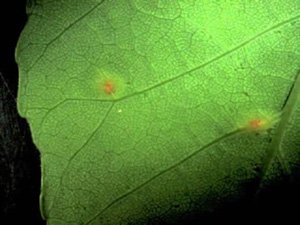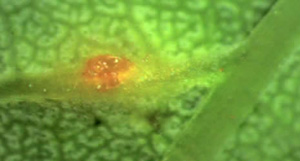DACF Home → Bureaus & Programs → Maine Forest Service →Forest Health & Monitoring → Forest Pest Index → Ash Leaf and Twig Rust
Ash Leaf and Twig Rust

Photo: Maine Forest Service Forest Health and Monitoring Division
Description and Damage
Ash leaf and twig rust, caused by the rust fungus Puccinia sparganioides Ellis & Barth., is a disease which affects all three native ash species in Maine; white, green and black. It is sometimes called ash leaf rust or simply, ash rust. Ash rust also attacks salt marsh or cord grass (Spartina spp.) which is found in coastal tidewater areas.

Photo: Maine Forest Service Forest Health and Monitoring Division
Symptoms on ash appear first in mid June as small yellow to yellow-orange spots on upper leaf surfaces . About ten days later bright orange clusters of aecia (fungal spore producing structures) became apparent on leaf undersurfaces. Leaves often become distorted and petioles and twigs may develop wartlike swellings which also bear clusters of aecia. By early July affected leaf tissue on ash begins to die and severely affected trees appear scorched. By early August defoliation of heavily infected trees is well advanced. In some cases, trees infected may push a flush of new growth. Two or more successive epidemic years may result in a stag-headed condition of trees. Affected trees may be predisposed to winter damage and to secondary infection by wood decay organisms. Repeated successive severe infections occasionally result in mortality of small, shaded trees. Though large landscape specimens rarely are killed outright, the disease is so disfiguring that control practices may be warranted.
Control*
Periodic applications of certain fungicidal sprays may provide effective control but these have apparently not been thoroughly tested under Maine conditions. We suggest trial applications of Systhane WSP (myclobutanil) in situations where epiphytotics (epidemics) of this disease threaten valuable landscape specimens. Apply myclobutanil three times, once beginning at budbreak (mid May), then twice again at ten day to two week intervals.
For further information about this pest you should contact the MFS Insect and Disease Lab, 168 State House Station , Augusta, ME 04333-0168, tel. 287-2431.
*NOTE: These recommendations are not a substitute for pesticide labeling. Read the label before applying any pesticide. Pesticide recommendations are contingent on continued EPA and Maine Board of Pesticides Control registration and are subject to change.
**Some formulations are restricted-use pesticides and may be purchased or used only by certified applicators.
Caution : For your own protection and that of the environment, apply the pesticide only in strict accordance with label directions and precautions.
MAINE DEPARTMENT OF AGRICULTURE, CONSERVATION AND FORESTRY
Maine Forest Service - Forest Health and Monitoring Division - February 1996